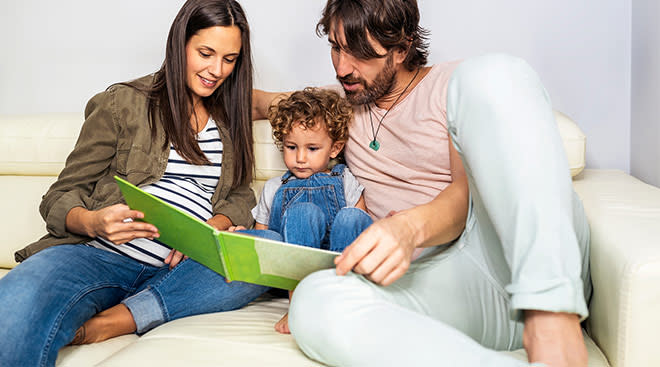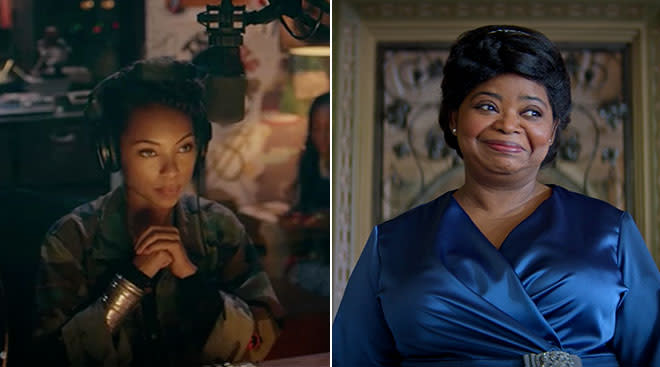How and When Do Babies Develop Object Permanence?
If a ball rolls under the couch and no one can see it, does it still exist? Well, yes, but it actually takes babies months after birth to learn this. The concept that people and objects don’t simply cease to be once they’re out of sight is known as object permanence, and this realization is an important milestone in a child’s development. So when do babies develop object permanence, exactly, and how can you help your little one along? Read on for expert insights.
Object permanence is the understanding that objects continue to exist even when you can no longer see them. “Object permanence is important to a baby’s development, as it’s the beginning of their symbolic thought, or their ability to visualize or form mental images of things that are not physically present,” says Francyne Zeltser, PsyD, a psychologist based in Valley Stream, New York. Infants who are too young to grasp object permanence may completely forget about a toy they had been playing with if, say, it’s covered with a blanket. “For them, the toy has completely vanished from the world,” explains Catherine Pourdavoud, MD, associate pediatrician at Calabasas Pediatrics in California.
Once baby understands object permanence, though, they’ll know to search for the thing that’s no longer visible. For example, “If you cover a ball with a blanket, your child looks for it because they know it’s still there, just covered up. That’s object permanence,” says Jennifer Trachtenberg, MD, an assistant clinical professor of pediatrics at The Icahn School of Medicine at Mount Sinai in New York City.
The notion of object permanence was first conceived by Swiss developmental psychologist Jean Piaget, which he outlined in his theory of cognitive development, published in 1936. Piaget believed babies begin understanding object permanence around 8 months old. However, according to Pourdavoud, research now suggests it may develop as early as 4 to 7 months of age.
Object permanence features prominently in the first of four stages of cognitive development that Piaget describes. During the sensorimotor stage, which spans from birth to around 24 months, babies learn about the world through sensory and physical exploration of their environment. The goal of this period, Piaget asserted, is to develop an understanding of object permanence, and a mastery of object permanence is needed before they can progress to the second stage of development.
Piaget’s theory is still widely used in branches of psychology, but it has also sustained some criticism from today’s experts. Piaget assumed that all children go through developmental stages at precisely the same age—but he didn’t account for the many factors that affect a child’s growth, including parenting styles, level of social interaction, personality types and more. “Current research suggests that there are ranges for children’s development, and later researchers often found that children were more capable at an earlier age than Piaget’s original research indicated,” Zeltser says.
The best way to help baby establish an understanding of object permanence is by interacting with them. If you’ve ever played peek-a-boo with baby, you’ve already begun teaching them about object permanence without even realizing it! It’s a simple game to adults, but to babies, it’s a fun revelation. “The joy that the participants in this game experience is the reassurance that people come back,” says Elizabeth Berger, MD, a child psychiatrist. Your child knows you’re still there even when you cover your face, and happily giggles when they see you again as you exclaim “peek-a-boo!”
Here are some other games to help teach baby about object permanence:
• Hide objects. Show your child a few toys, then hide them beneath a pillow or blanket or in another spot they can easily reach. Encourage baby to look for the toys by using hints, Pourdavoud suggests. You can even hide and encourage baby to crawl around and find you. “Baby will get so excited to hear and follow your voice,” she says. If baby struggles at first, don’t fret—finding objects will become easier for them over time.
• Call out to baby when you’re in another room. If you need to step away from baby for a moment, take the opportunity to reinforce object permanence. “Talking and singing to baby while you’re out of their view is a great way to help them feel safe and comforted as they learn that you’re still present even when not within eyesight,” says Haley Neidich, LCSW, a psychotherapist based in Tampa Bay, Florida.
• Make a homemade jack-in-the-box. It’s easier than you might think! Use scissors to punch a hole in the bottom of a large plastic container. Slide a pencil, ruler or stick through the hole, attach a small, colorful toy (think: finger puppet) to the tip—and voila! To play with baby, pull the stick down to hide the toy, then push back up so it’s visible again.
• Play the ball and cup game. Pourdavoud suggests hiding a small, colorful ball beneath a plastic cup. Lift the cup to reveal the ball, then cover the ball again. Note: to keep baby safe, make sure the ball is large enough that it can’t fit through a toilet paper roll, to avoid a potential choking hazard, she says.
• Give baby an object permanence box. An object permanence box is a wooden toy originally developed by Maria Montessori, a 19th century physician. To play, baby puts a large wooden ball into a hole at the top of the box. The ball disappears momentarily, then rolls out into a tray where your little one can grab it and repeat the game. “This developmental tool will help babies learn object permanence in a direct and concrete manner,” says Neidich.
So how will you know when baby truly understands object permanence? Keep tabs on whether baby does the following:
- Recognizes faces
- Recognizes familiar objects
- May cry when you leave the room
- Knows to search for a hidden toy
- Keeps searching for a toy when you move it from its original hiding place to a new location
- Experiments by intentionally dropping items and then looking for the objects they’ve dropped
- Points to the correct location if you ask where an object is
- Waves goodbye to a parent walking out the door
While studying infant behavior, Piaget would show a toy to a baby before hiding it or taking it away, and then wait to see if the baby would search for the object or become upset. He assumed that babies who cried at the toy’s disappearance lacked an understanding of object permanence, while those who looked for the toy had fully grasped the concept. But experts now point out that this isn’t necessarily the case. Babies may become upset precisely because they understand that the toy exists but isn’t available. This is especially true in the case of separation anxiety, when children know a parent or loved one has left and yearns to be with them. Plus, there may be other reasons why a baby doesn’t look for a hidden toy—they may be physically unable to search, or they may simply be uninterested in the toy itself.
Understanding object permanence is an important aspect of a child’s development, but at the end of the day, it’s not something you need to stress about—that knowledge will come about naturally as your child continues to learn and grow, make observations and note cause and effect. “Whether balls that roll under the sofa are still there or whether they have disappeared forever—this is only one observation among hundreds that babies will make on their own,” Berger says. “The child’s growing understanding of how the world works is a magnificent explosion of knowledge that happens…without any special instruction.”
Please note: The Bump and the materials and information it contains are not intended to, and do not constitute, medical or other health advice or diagnosis and should not be used as such. You should always consult with a qualified physician or health professional about your specific circumstances.
Plus, more from The Bump:
Catherine Pourdavoud, MD, is an associate pediatrician at Calabasas Pediatrics in California.
Jennifer Trachtenberg, MD, is board-certified pediatrician in private practice in New York City. She also serves as a spokesperson for the American Academy of Pediatrics and an assistant clinical professor of pediatrics at The Icahn School of Medicine at Mount Sinai, where she earned her medical degree.
Francyne Zeltser, PsyD, is a licensed psychologist based in Valley Stream, New York. She works as a certified school psychologist in Valley Stream 30 Union Free School District. She received her degree in psychology from St. John’s University in New York City.
Elizabeth Berger, MD, is a board-certified child psychiatrist in Indianapolis and New York City with more than 30 years experience treating children and families. She is also the author of the book Raising Kids with Character: Developing Trust and Personal Integrity in Children. Berger earned her medical degree from the David Geffen School of Medicine at UCLA.
Haley Neidich, LCSW, PMH-C, is a licensed psychotherapist, clinical social worker and parenting coach based in Tampa Bay, Florida. She earned her Master’s degree from the Columbia University School of Social Work in 2008.
Navigate forward to interact with the calendar and select a date. Press the question mark key to get the keyboard shortcuts for changing dates.




















































